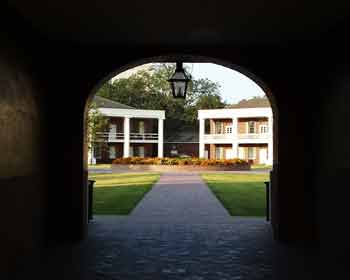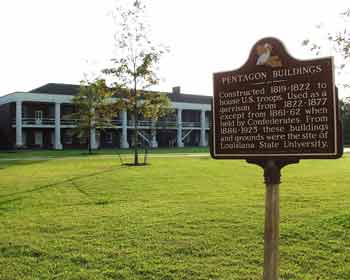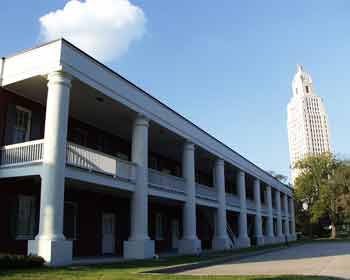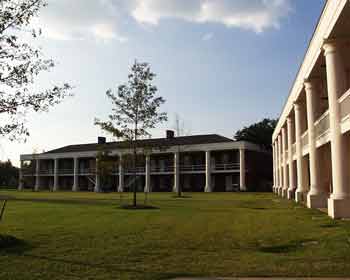Pentagon Barracks


History
Colonial period
The capitol grounds have been used as military facilities since the
early 1700s. The area was first inhabited by the French, after being discovered by French
explorer Pierre Lemoyne, Sieur d’Iberville around 1700. Baton Rouge was ceded to the
British in 1763. The British first fortified the area in 1779, and called it Ft.
Richmond. The Spanish captured the fort in September 1779 in what was to be the only
battle of the American Revolution fought outside the confines of the 13 original colonies.
The Spanish renamed it Ft. San Carlos. The fort was held by the Spanish until it was
captured by a band of armed citizens in September of 1810. This rebellion spawned the West
Florida Republic, an independent state. The West Floridians renamed the facility Fort
Baton Rouge. Later that year, the republic petitioned the United States for acceptance
into the union. As a result, U.S. troops moved into the fort.


Baton Rouge Arsenal and Ordnance Depot
In 1816, the fort at Baton Rouge was selected by the U.S. Army
Ordnance Department as an ordnance depot. This area seemed the natural choice since
supplies could be moved quickly to New Orleans from Baton Rouge, should the former be
attacked. A site was selected and plans drawn by Lt. James Gadsen, a young Army engineer.
Gadsen would later mastermind the famous Gadsen Purchase from Mexico.
The contract was awarded to Joel Hill. Hill already was under contract with the
Quartermaster department to build four barracks buildings and a combination
commissary-warehouse building. The Ordnance warehouse was connected to the Quartermaster
building. These four barracks and the fifth, dual-purpose building made up the Pentagon
Barracks. The four barracks stand today, but the fifth building was poorly constructed and
was torn down the same year it was built. At this point, the fort became known as the
Baton Rouge Arsenal and Ordnance Depot.
The Ordnance depot soon grew to be the largest in the South. It served as a main supply
depot during the Mexican War in 1847.
In January 1861, the barracks were captured by state militia forces under Louisiana Gov.
Thomas Overton Moore. The Confederate Army soon took over. Many Louisiana volunteer units
in the Civil War were supplied with ordnance left at the fort. The fort was recaptured by
Union forces in August of 1862 and held for the balance of the war.
It remained an Ordnance depot until control was formally transferred from the Ordnance
Department to the Quartermaster Department in 1869. The post was deactivated on June 6,
1879 and U.S. troops moved out, leaving a single Ordnance sergeant as caretaker.
Louisiana State University site
In 1884, the buildings and grounds were transferred to the Department of the Interior.
Louisiana State University leased the land and buildings from the federal government
beginning in 1886 and in 1902, the university was given full title to the property. The
Pentagon Barracks were used to house cadets.
Post LSU
In 1926, Louisiana State University moved to its present location,
down river from the barracks, in preparation for the new state capitol. Cadets were housed
there until 1932. Co-eds were housed in the barracks until 1950
At this point, the Pentagon Barracks were renovated into apartments for LSU faculty and
other state employees. In 1931 and 1932, other buildings on the old post were razed
to make room for the "new" State Capitol.
State of Louisiana
In 1951, ownership was transferred to the State. While some
apartments remained, Gov. Earl K. Long ordered that some of the space be used as state
offices. Some 12 state agencies were housed there by 1966. In 1976, the buildings were
placed on the National Historic Register.
Today, the Pentagon Barracks are still used as apartments for state officials and offices
for state agencies. The Office of Lieutenant Governor is located there.
The Pentagon Barracks have played host to many
American historical figures. Several U.S. presidents have graced the buildings, in various
capacities. Perhaps the most recognized here in Baton Rouge is Zachary Taylor, who
commanded the garrison on three separate occasions and was post commander when he was
elected president. Records also indicate that Abraham Lincoln spent the night here, and
Ulysses S. Grant stayed at the post as a general. Grant was also stationed in the
Natchitoches area as a young lieutenant. Although not a U.S. president, Jefferson Davis,
president of the Confederate States of America, stayed at the garrison as a civilian.
Davis had earlier served as a lieutenant under Taylor and then married his daughter.
In later years, presidents Taft and Harding made stops at the building.
Many military figures have either visited or been garrisoned here.
Captain James Gadsen, a U.S. Army engineer, designed the barracks. Gadsen later went on to
engineer the Gadsen Purchase, the last continental land acquisition by the United States.
Confederate generals Robert E. Lee, Thomas (Stonewall) Jackson, Albert S. Johnston, Joseph
E. Johnston, James Longstreet, John B. Hood and Nathan Bedford Forrest were all at one
time visitors to the Pentagon Barracks. Union generals Phillip H. Sheridan, George A.
Custer, George B. McClellan, William S. Rosecrans and Winfield Scott are also recorded as
having visited. Gen. Scott also earlier served at the garrison as an artillery lieutenant.
Near to the hearts of many Louisianians are visitors such as Gen.
William Tecumseh Sherman, who was the first president of the military academy that is now
Louisiana State University. Sherman resigned that position at the onset of the Civil War,
to join the Union forces. All of his cadets joined the Confederate forces.
Entered into Pentagon Barracks records as visitors are Confederate Gen.
P.G.T. Beauregard, who fired the first cannon shots at Ft. Sumter, starting the Civil War.
Confederate Bishop and Gen. Leonidas Polk, after whom Louisiana’s Ft. Polk is named,
visited after the Civil War. Polk later became the first Protestant Episcopal Bishop of
Louisiana.
Museum and Gift Shop
The Pentagon Barracks Museum contains many displays relating to the history of the
facility. The gift shop, located adjacent to the museum, is open from 10:00 a.m. until
4:00 p.m. Monday through Friday.